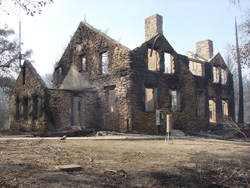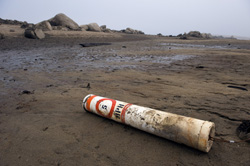The Prospects for Our Parks
Climate issues have already begun to put California State Parks’ natural, cultural, and recreational resources at risk. Even in protected park wildlands, the expected rapid pace of climate change will make it difficult for natural communities to cope. Warming will require many plants and animals to adjust their ranges in order to stay in their favored climate zones. Some species that aren’t able to move may disappear. Familiar ecologicial groupings may break down, along with vital species interactions.
Due to the growing risk of wildfire, many cherished historical sites and cultural treasures are increasingly jeopardized. (The Dyar House at Cuyamaca Rancho State Park was one such casualty.) Such fires can also damage ancient archaeological sites or expose them to looting and vandalism. Extreme fire danger is likely to close more parks more often.

At Cuyamaca Rancho State Park, the ruins of the Dyar House, which was destroyed in the 2003 Cedar Fire, are a testament to the risk wildfires pose to cherished historical sites and cultural resources.
Rising seas will cause popular beaches and fragile coastal wetlands to diminish in size and quality. Increased wave erosion and storm damage to park facilities can be expected, too.
Higher temperatures will shrink mountain snowpacks, impacting winter recreation. With more precipitation falling as rain instead of snow, river parks downstream will be more vulnerable to seasonal flooding. Drought and draw-down will make reservoir parks less attractive to summer visitors. And anglers will catch fewer cold-water fish.

Drought and draw-down of reservoirs will lead to a loss of recreational opportunities, and sights such as this speed limit buoy at Folsom LakeState Recreation Area will become increasingly common.
